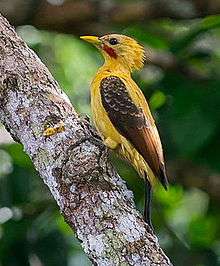Cream-colored woodpecker
The cream-colored woodpecker (Celeus flavus) is unmistakably recognizable by its pale but distinct yellow plumage and beak, long erect crest, dark brown wings and black tail. The male is differentiated by the female by its thick bright red malar stripe. The yellow plumage may darken to a browner or darker tone if soiled. The cream-colored woodpecker is 24–26 cm in height and weighs 95-130g.
| Cream-colored woodpecker | |
|---|---|
 | |
| male at Manú National Park, Madre de Dios, Peru | |
| A female at Iranduba, Amazonas state, Brazil | |
| Scientific classification | |
| Kingdom: | Animalia |
| Phylum: | Chordata |
| Class: | Aves |
| Order: | Piciformes |
| Family: | Picidae |
| Genus: | Celeus |
| Species: | C. flavus |
| Binomial name | |
| Celeus flavus (Statius Muller, 1776) | |
Taxonomy
The four recognized subspecies of Celeus flavus are C. f. flavus, C.f. peruvianus, C.f. tectricialis and C.f. subflavus. These subspecies interbreed and produce many intermediates, blurring their original designated geographical boundaries. C.f. subflavus is significantly larger than its nominate, weighing on average 200g.
Range and Habitat
Native to South America, from Colombia, Venezuela and the Guianas to Peru, Bolivia, and the eastern part of Brazil, including a southeast Brazil coastal strip. The cream-colored woodpecker inhabits rainforests, mangroves, forests near water, deciduous woodland as well as cacao plantations. It does not migrate.
Behavior
Vocalization
The cream-colored woodpecker emits a high-pitched laugh: "wutchuk kee-hoo-hoo-hoo" or "pueer, pueer, purr, paw" with the final note in a lower pitch. During interaction with other bird species, it may repeat "kiu-kiu-kiu-kiu". Less raspy and higher pitched than vocalizations of Chestnut woodpeckers (Celeus elegans).
Diet
Diet consists mainly of arboreal ants and termites, but generally supplemented by seeds and fruit. Forages singly and in groups, on trees as well as the ground. Frequently sighted pecking at termite nests on trees.
Breeding
April to June in Colombia and slightly earlier in Venezuela. Nesting habits have not been documented.[2]
Status and Conservation
The cream-colored woodpecker is considered as generally uncommon but has been established as of Least Concern status. However, due to decreases every year in suitable habitat, it is predicted to decrease in population numbers over the next few decades.
References
- BirdLife International (2012). "Celeus flavus". IUCN Red List of Threatened Species. 2012. Retrieved 26 November 2013.CS1 maint: ref=harv (link)
- del Hoyo, Joseph (1992). Handbook of the Birds of the World - Volume 7: Jacamars to Woodpeckers. Barcelona: Lynx Edicions. pp. 522. ISBN 84-87334-37-7.
- Birds of the World by Colin Harrison and Alan Greensmith, Eyewitness Handbooks
External links
- Stamps (for Colombia) with RangeMap
- Cream-colored woodpecker photo gallery VIREO Photo-High Res
- Photo-High Res; Article webserv.nhl.nl—Birds of Suriname
- Photo-High Res; Article tekipaki
